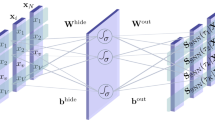Abstract
Remaining useful life (RUL) prediction has been a topic of practical interest in many fields involving preventive intervention, including manufacturing, medicine and healthcare. While most of the conventional approaches suffer from censored failures arising and statistically circumscribed assumptions, few attempts have been made to predict RUL by developing a survival learning machine that explores the underlying relationship between time-varying prognostic variables and failure-free survival probability. This requires a purely data-driven prediction approach, devoid of any a survival model and all statistical assumptions. To this end, we propose a time-dependent survival neural network that additively estimates a latent failure risk and performs multiple binary classifications to generate prognostics of RUL-specific probability. We train the neural network by a new survival learning criterion that minimizes the censoring Kullback-Leibler divergence and guarantees monotonicity of the resulting probability. Experiments on four datasets demonstrate the great promise of our approach in real applications.
Access this chapter
Tax calculation will be finalised at checkout
Purchases are for personal use only
Similar content being viewed by others
References
Buckley, J., James, I.: Linear regression with censored data. Biometrika 66(3), 429–436 (1979)
Chen, L., Wang, S.: Central clustering of categorical data with automated feature weighting. In: IJCAI, pp. 1260–1266 (2013)
Cox, D.R.: Regression models and life tables. J. R. Stat. Soc. Ser. B. Stat. Methodol. 34, 187–220 (1972)
Faraggi, D., Simon, R.: A neural network model for survival data. Stat. Med. 14(1), 73–82 (1995)
Fisher, L.D., Lin, D.Y.: Time-dependent covariates in the Cox proportional-hazards regression model. Annu. Rev. Public Health 20(1), 145–157 (1999)
Ishwaran, H., Kogalur, U.B., Blackstone, E.H., Lauer, M.S.: Random survival forests. Ann. Appl. Stat. 2, 841–860 (2008)
Katzman, J., Shaham, U., Bates, J., Cloninger, A., Jiang, T., Kluger, Y.: DeepSurv: personalized treatment recommender system using a Cox proportional hazards deep neural network. BMC Med. Res. Methodol. 18, 18–24 (2018)
Kim, H., Golub, G.H., Park, H.: Imputation of missing values in DNA microarray gene expression data. In: CSB, pp. 572–573 (2004)
Li, H., Ge, Y., Zhu, H., Xiong, H., Zhao, H.: Prospecting the career development of talents: a survival analysis perspective. In: KDD, pp. 917–925 (2017)
Li, Y., Wang, J., Ye, J., Reddy, C.K.: A multi-task learning formulation for survival analysis. In: KDD, pp. 1715–1724 (2016)
Li, Y., Wang, L., Wang, J., Ye, J., Reddy, C.K.: Transfer learning for survival analysis via efficient L2, 1-norm regularized Cox regression. In: ICDM, pp. 231–240 (2017)
Li, Y., Xu, K.S., Reddy, C.K.: Regularized parametric regression for high-dimensional survival analysis. In: SDM, pp. 765–773 (2016)
Lin, H.C., Baracos, V., Greiner, R., Chun-Nam, J.Y.: Learning patient-specific cancer survival distributions as a sequence of dependent regressors. In: NIPS, pp. 1845–1853 (2011)
Michalewicz, Z., Schoenauer, M.: Evolutionary algorithms for constrained parameter optimization problems. Evol. Comput. 4(1), 1–32 (1996)
Moghaddass, R., Rudin, C.: The latent state hazard model, with application to wind turbine reliability. Ann. Appl. Stat. 9(4), 1823–1863 (2014)
Sinha, D., Ibrahim, J.G., Chen, M.: A Bayesian justification of Cox’s partial likelihood. Biometrika 90(3), 629–641 (2003)
Street, W.N.: A neural network model for prognostic prediction. In: ICML, pp. 540–546 (1998)
Vinzamuri, B., Li, Y., Reddy, C.K.: Active learning based survival regression for censored data. In: CIKM, pp. 241–250 (2014)
Wang, L., Li, Y., Zhou, J., Zhu, D., Ye, J.: Multi-task survival analysis. In: ICDM, pp. 485–494 (2017)
Wang, P., Li, Y., Reddy, C.K.: Machine learning for survival analysis: a survey. ACM Comput. Surv. 51(6), 1–36 (2019)
Wei, L.J.: The accelerated failure time model: a useful alternative to the Cox regression model in survival analysis. Stat. Med. 11(14–15), 1871–1879 (1992)
Wilamowski, B.M., Yu, H.: Neural network learning without backpropagation. IEEE Trans. Neural Netw. 21(11), 1793–1803 (2010)
Wu, Y., Yuan, M., Dong, S., Lin, L., Liu, Y.: Remaining useful life estimation of engineered systems using vanilla LSTM neural networks. Neural Comput. 275, 167–179 (2018)
Yu, S., et al.: Privacy-preserving Cox regression for survival analysis. In: KDD, pp. 1034–1042 (2008)
Zhang, J., Chen, L., Vanasse, A., Courteau, J., Wang, S.: Survival prediction by an integrated learning criterion on intermittently varying healthcare data. In: AAAI, pp. 72–78 (2016)
Zhang, J., Wang, S., Courteau, J., Chen, L., Bach, A., Vanasse, A.: Predicting COPD failure by modeling hazard in longitudinal clinical data. In: ICDM, pp. 639–648 (2016)
Acknowledgments
This work was supported by the National Natural Science Foundation of China (NSFC) under Grant No. 61672157, the Natural Sciences and Engineering Research Council of Canada (NSERC) under Grant No. 396097-2010, the program PAFI of Centre de Recherche du CHUS.
Author information
Authors and Affiliations
Corresponding author
Editor information
Editors and Affiliations
Rights and permissions
Copyright information
© 2019 Springer Nature Switzerland AG
About this paper
Cite this paper
Zhang, J., Wang, S., Chen, L., Guo, G., Chen, R., Vanasse, A. (2019). Time-Dependent Survival Neural Network for Remaining Useful Life Prediction. In: Yang, Q., Zhou, ZH., Gong, Z., Zhang, ML., Huang, SJ. (eds) Advances in Knowledge Discovery and Data Mining. PAKDD 2019. Lecture Notes in Computer Science(), vol 11439. Springer, Cham. https://doi.org/10.1007/978-3-030-16148-4_34
Download citation
DOI: https://doi.org/10.1007/978-3-030-16148-4_34
Published:
Publisher Name: Springer, Cham
Print ISBN: 978-3-030-16147-7
Online ISBN: 978-3-030-16148-4
eBook Packages: Computer ScienceComputer Science (R0)




